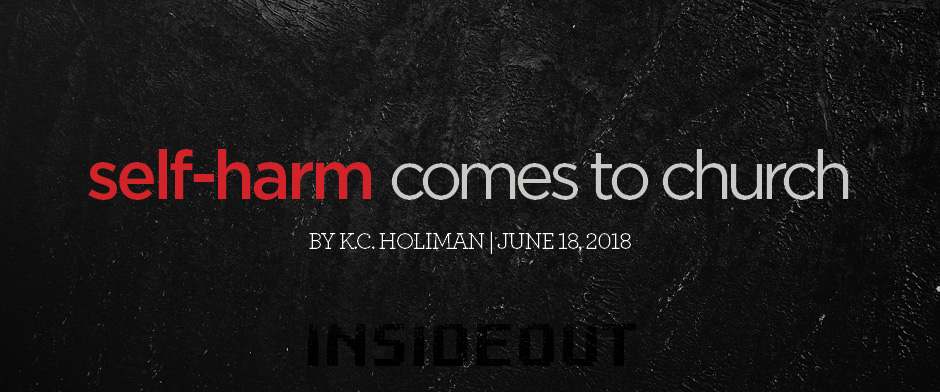Self-Harm Comes to Church

Self-harm, also known as self-injury, is something one in five young ladies and one in seven young men will engage in during their teenage and early adult years. Most of us have heard of the common self-harm practice of cutting yourself, but here are other ways people, especially young people, also inflict harm upon themselves:
- Cutting
- Burning
- Interfering with wound healing (picking or reopening wounds)
- Punching or hitting oneself or other objects
- Inserting objects into the skin
- Purposely bruising or breaking one’s bones
- Certain forms of hair pulling
To many, self-harm could be hard to understand or grasp. Why would someone inflict bodily harm on themselves? Why would someone purposely hurt themselves? I’ve asked these questions as a former youth pastor when I heard some youth were doing this in our youth group. It’s easy to be judgmental and think someone must be crazy to do such a thing.
But I had to take the time to research the cause and effects of these actions and pray for God’s wisdom to help our young people. First we must understand that the act of harming oneself is a physical reaction to an emotional problem. Many claim self-harm feels like an emotional release or a way to physically express the emotional distress they are feeling.
Self-harm is directly related to other emotional disorders such as depression, anxiety, and suicidal tendencies. These struggles face all youth in and out of the church. Studies show that approximately 20% of teens will suffer from depression before they reach adulthood. Between 10-15% of teens are dealing with one or more symptoms of depression. And depression increases teens’ risk of suicide by twelve times.
Sadly, suicide is the second leading cause of death for teens and college-aged youth. More teenagers and young adults die from suicide than from cancer, heart disease, AIDS, birth defects, stroke, pneumonia, influenza, and chronic lung disease combined. Each day in the U.S., an average of over 3,470 young people in high school attempt suicide. Each day.
All that adds up to the chance of youth/young adults inflicting harm on themselves. I’ll ask what some adults are asking: aren’t these young people? Why are they so depressed? Why are they stressed? They’re not tasked with the responsibilities and weight of most adults, so why are they dealing with these issues? The truth is you young people deal with more unique cultural and societal pressures today than ever before, and you are dealing with them at younger and younger ages.
I work in the classroom with middle school and high school students, so I can testify to the increased degree of exposure you have to immorality and ungodliness like never before through social media platforms such as Facebook, Twitter, and Snapchat. Sixth graders are becoming familiar with difficult and even dangerous issues youth used to be exposed to late in high school. The cultural and societal pressures to be in the “in crowd” and keep up with your friends and classmates have you hearing, seeing, and doing things you never would have years ago.
As a result when a young man or young lady feels like they just can’t fit into one of these peer “molds,” they feel like an outsider and become lonely and eventually depressed, which can lead to self-harm. Sometimes youth who self-harm are not who you would expect. Sometimes they’re popular, in sports, school clubs, and even generally accepted among their peers. But on the inside they may be hurting and battling depression from a bad home life or some other negative personal experience from their past.
Either way our eyes and hearts must be open to them and considerate that this is a real issue youth and young adults deal with every day. The odds say it’s even in your youth/ young adult group. While I was growing up in a small town high school, I remember one of my friends who was fun and seemed to happy. One day she rolled up her sleeves, and I saw multiple scars going up and down her arm. I asked her what those marks were from, and she told me she was injured in a car wreck. I believed her but the image of those marks never left my mind. Months later her best friend and I were talking and I asked if he knew about her car wreck. He looked at me surprised and said, “That’s not from a car wreck; she’s a cutter.” Her embarrassment and shame kept her from telling me the truth about her condition, and she hid it for years.
If you are struggling with depression, anxiety, or self-harm, go to someone you trust and talk to them about it. Go to God and tell Him about it. The pain you’re feeling, the stress you’re encountering, the pressure you’re feeling is not from God; it’s from the enemy. But I John 4:4 tells us, “He who is in you is greater than he who is in the world.” You have a power greater than any bout of depression, any suicidal tendencies, any anxiety. That is the power of the Holy Ghost.
The struggles, the battles you face, the depression you fight are not meant to destroy you but to prepare you to help others. II Corinthians 1:3-5 explains God comforts us in our troubles so we can comfort those who are in trouble with the same comfort we receive through Jesus. There is a purpose, a reason why we deal with the things we do. What you’re feeling today is not meant to destroy you; it’s meant to save others.
Hubby to Shaina; Daddy to Nevaeh and Natalie; youth pastor; Northwest sectional youth leader; church planter to Arlington, Texas; and proud “bus kid”







